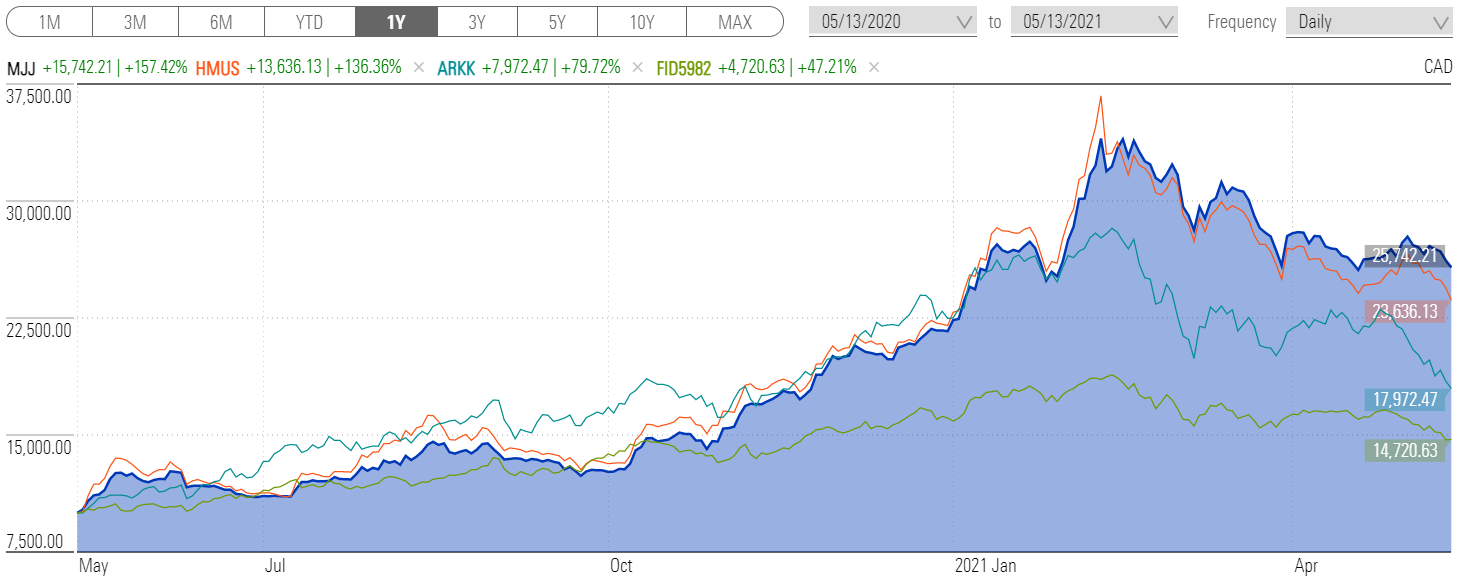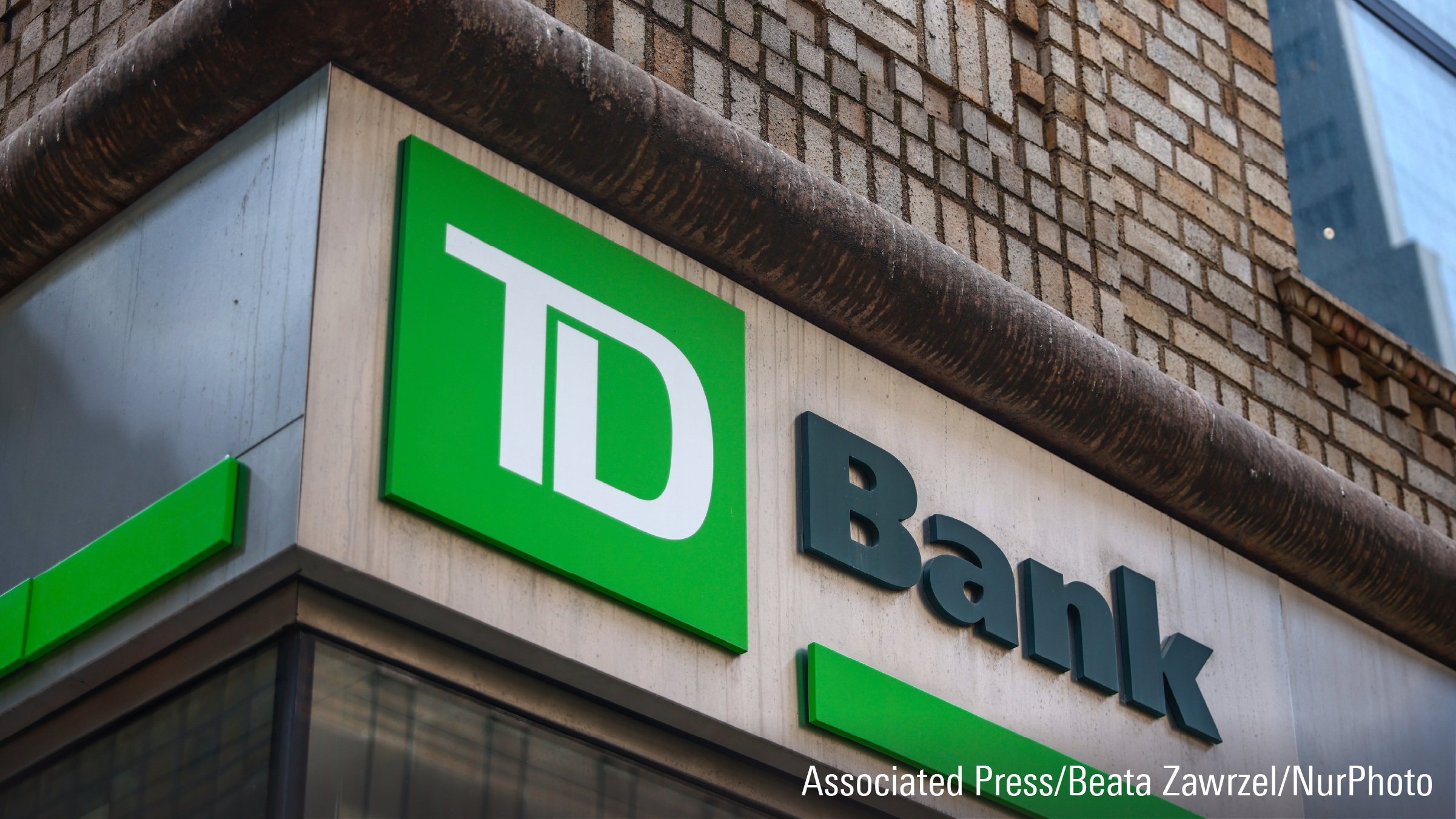
For their fix of high-octane returns, investors have been piling into top-performing tech funds from the likes of Cathie Wood at ARK Invest to Mark Schmehl at Fidelity Canada. But since the start of the year, it turns out cannabis investors have had some of the hottest portfolios.
In fairness, the comparison is a bit ‘apples and oranges’, and losses in technology funds have particularly been hit by pervasive fears of inflation. But this is the realm of high-growth investors, and cannabis funds have been stealing the spotlight in tough markets.
“The cannabis sector continues to show its risk-on characteristics running through the ebbs and flows of the evolving situation both sides of the border, and heightened equity market volatility,” note Greg Taylor and Nawan Butt, who head up the Purpose Marijuana Opportunities Fund (MJJ), adding that “The fundamentals remain robust as ever and continually improve.”
Cannabis investors who’ve been in the Canadian LP (licensed producer) space will be able to put the growth potential in perspective when looking at what’s happening now with U.S. Multi-State Operators (MSOs).
“Canadian LPs are trading at an average enterprise value to sales of 14.3 times sales versus the MSOs at 6.3 times sales,” says Mark Noble, Executive Vice-President of ETF Strategy at Horizons ETFs, which runs the Horizons US Marijuana ETF (HMUS), “This valuation difference is staggering, given the top 10 MSOs are expected to generate more than $10 billion in revenue in 2021 versus $4 billion in revenue for the top 10 LPs.”
Higher, Stronger Growth
Reflecting the opportunities in the U.S., the ETFs from Purpose and Horizons have returned a stunning 157.42% and 136.36%, respectively, over the past year as of May 13, 2021. That’s in the realm of multiples when compared to some of the highest-flying funds like the ARK Innovation ETF (ARKK) and Fidelity Global Innovators Class F (FID5982).

Source: Morningstar.ca, as of May 13, 2021 - Click here for a larger image of the chart
Beyond a year back, of course, both Wood and Schmehl have beaten U.S. cannabis strategies, and it aligns with the tendency for (relative) diversification to outperform over the long run. At the same time, U.S. cannabis is new and for investors looking to get tactical with a possible satellite strategy, there’s a lot of runway left down South.
What’s Next?
“We think the U.S. has the highest potential and offers the fastest growth of any market. But the U.S. regulatory environment is murky, with individual states legalizing recreational or medical cannabis while it remains illegal federally. Eventually, we expect federal law will be changed to allow states to choose the legality of cannabis within their borders. We forecast nearly 25% average annual growth for the U.S. recreational market and more than 10% for the medical market through 2030,” says Morningstar analyst Kristoffer Inton.
All three experts agree.
“U.S. legalization is the key topic that investors are watching. Not only is the possibility of federal legislation from Congress and the U.S. Senate on the table for 2021, but it would appear a lot of the upside potential of this is heavily priced in, particularly on the Canadian LP side,” says Noble.
Taylor and Butt say they’re “really in favour of American names vs. Canadian,” citing U.S. policy progress at both state and federal levels, with many catalysts ahead. At the federal level, they highlight the SAFE Act, which recently passed the House of Representatives for the fourth time and provides a framework for institutional money to enter the picture. “We expect the Senate to continue deliberating on the Act but find confidence that an increasing number of Republicans show their support.”
At the state level, “reform continues at a strong pace with multiple states evaluating or passing cannabis legalization frameworks to take advantage of increasing tax opportunities and job creation related to the industry,” notes Taylor and Butt. “There are currently 10 state legislatures debating the legalization of either adult-use or medical cannabis—many of these states are expected to pass some form of reform within the year after states such as New York and Virginia implemented adult-use legalization frameworks this year.”
Proof’s in the Pot Sales…and Funding…and Mergers
The opportunities around these developments can be gleaned from sales in the States so far. “We continue to see record sales for emerging markets such as Illinois and Massachusetts while the mature markets of Oregon, Washington, and Nevada continue to grow topline sales,” says Taylor and Butt, adding that operators continue to post record sequential growth.
There are other signs of success in the industry with a growing capital base. “Green Thumb Industries (GTII) raised US$217 million in April at a 7% interest rate, making it one of the first multi-state operators to raise such large debt with a single-digit rate,” says Taylor and Butt, “Elsewhere, ancillary services firm Hydrofarm priced a US$269M equity offering with ease as many interested institutions are sidelined into investing in nonplant-touching exposure only.”
Other promising corporate events include some formidable mega-mergers. “We are already seeing some consolidation in the MSO market based on the U.S. outlook. On May 10, 2021, Trulieve (TRUL) Cannabis Corp and Harvest Health & Recreation (HARV) announced one of the largest Cannabis-related mergers,” says Noble, adding that the merger gives the two firms a huge foothold in the populous Arizona and Florida markets,” he adds.
What Are the Risks?
“The most important risk is the pace and status of legalization in the U.S., which determines when and where cannabis can be legally sold. If federal legalization does not occur or takes meaningfully longer than we expect, the impact on our fair value estimates would be significant. Although there is growing public support, legalization is politically divisive, with most Republican support coming only in the form of states’ rights,” points out Inton.
Taylor and Butt say problems could arise with any issues if the U.S. government changes its mind or delays, but add that “this is the best chance in years for legalization.” Taylor and Butt also mention companies struggling with plans as a potential risk, while adding that issues facing other hot stocks – like cost inflation – could be a non-issue for cannabis.
Inton adds that another risk is the black market. “Years of government efforts have done little to stem illegal cannabis, but a change to the ease of accessing black market supply could have a significant impact on the pricing power and thus the profitability of legal cannabis companies,” he says.
Noble says his primary concern for cannabis investors comes back to Canada. “The high valuations on Canadian LPs is my primary concern about the industry,” he says, “There is potential for downward revisions on the LPs potentially likely to occur, particularly since it appears the pace of Canadian cannabis sales may not grow at the same torrid pace as 2020 when cannabis sales were buoyed by lockdowns and pent-up demand during the COVID-19 pandemic. Even if sales growth stays relatively flat, the LPs continue to be priced for expansion in a market that appears to be potentially tapped out for now, apart from the potential for U.S. expansion. We have seen already, that the Canadian LP market as represented by the Horizons Marijuana Life Sciences Index ETF (HMMJ), is down about 18% over the last month for the period ended May 13, 2021.”
Taylor and Butt acknowledge that even the U.S. cannabis space has seen a bit of a sell-off as of late, but for different reasons. “A lot of this downtrend can be directly traced back to a mass de-risking through the hedge-fund space following the collapse of Archegos Capital. Many banks pulled back on their prime allowances to hedge funds, which have been the major shareholders in the U.S. cannabis space,” they say.
Risks ahead for the sector also bring us back to the nature of investing in high-growth, high-risk investments whether cannabis or tech. “Cannabis investing has proven to work for those who are patient,” says Taylor and Butt, “Headline news tends to mostly create noise in the space, but it’s important to see through the challenges of the short-term and focus on the fundamentals that will make the industry successful in five to ten years from now.”
Have You Found Your Niche?
Explore the latest Global Thematic Fund Landscape report here






















